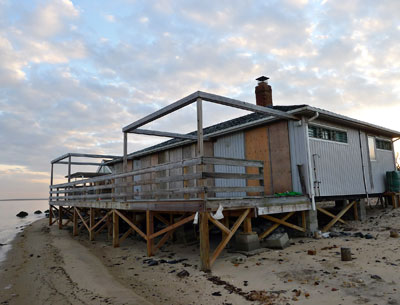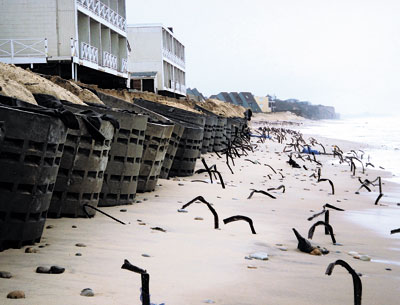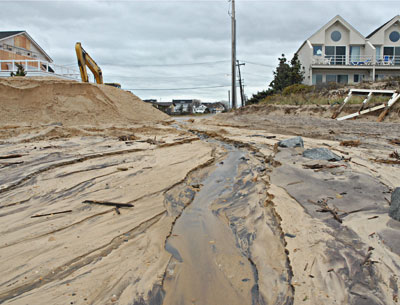Visions Of Wildflowers At Town Hall
Visions Of Wildflowers At Town Hall

East Hampton’s historic Town Hall, made from a grouping of vintage buildings that were donated by a collector who preserved barns and other structures from all over town, will be gussied up with plantings like those that might have once been found in their dooryard gardens, as well as other indigenous and deer-resistant plants, if a plan being developed by the town’s litter committee bears fruit. The buildings are now surrounded only by expanses of lawn. Besides beds of herbs, perennials, evergreens, and other shrubs, a wildflower meadow could take root to the east of the driveway entrance, supplanting an empty patch of grass. Deborah Klughers, the chairwoman of the litter committee, submitted a proposal to the East Hampton Town Board earlier this month, and this week said she hopes to get a go-ahead soon. Working with the committee on the project are Colette Gilbert, an herbalist who is the East Hampton Historical Society’s curator of education and who recently installed a historic and sustainable garden at the Mulford Farm, and Sara Shepherd, an herbalist and master gardener. With Ms. Klughers, they met recently with Marguerite Wolffsohn, the town planning director, to sketch out a multi-phased plan. The project, it is hoped, or at least its seasonal beginnings, could be unveiled on Earth Day in April. It all depends on the community, Ms. Klughers said this week. Organizers will be seeking the public’s opinions and ideas, and, crucially, donations of labor and materials from residents and businesses, such as nurseries and landscaping firms. Ms. Klughers said that a group of veterans, a local contractor, and others have already expressed interest in lending a hand. The gardens would be 100-percent organic and make use of recycled materials and would showcase not only the heirloom plants historically found here but traditional types of gardens and gardening techniques. Students could be involved in the process, and schools could use the gardens to teach children about the early settlers of East Hampton Town, according to the proposal. In addition, the committee envisions including senior citizens and the disabled, with the inclusion of a sensory garden that could be experienced using touch, smell, sight, sound, and taste. During the first phase of the project, Ms. Klughers said, plantings would be installed along the front facades of the historic Town Hall buildings, facing Pantigo Road. Garden beds would also be created along walkways leading from the parking lot to the main Town Hall entrance, and alongside a path that connects the main Town Hall campus to town offices at Pantigo Place. A raised bed under a Town Hall sign, on grass near the highway, has also been suggested. “Everything that we want to do is going to depend on people helping us,” said Ms. Klughers. No funding from the town is sought. Should the project be approved, the litter committee could accept donations, which would be funneled through the town and collected in a dedicated fund. The mission of the town-appointed committee includes promoting “community beautification” and “enhanc[ing] the quality of life for the citizens of East Hampton,” as well as implementing educational projects. Brainstorming is still under way, but in order to make the gardens an “interactive learning and teaching experience,” according to the proposal, there could be plaques listing the plants’ scientific and common names, brochures with information about how certain plants were used in the past and how they could be used today, and other informational initiatives, such as a Web site with local planting and gardening information. Schoolchildren, the committee anticipates, could work the gardens as a way to fulfill their community service requirements. “Maybe we’ll grow up a few new farmers while we’re at it,” the proposal says. Herbs, flowers, or food grown at Town Hall could be donated to those in need at the end of the growing season, the proposal anticipates. “It could be something special,” Ms. Klughers said. Garden planners would develop a five-year plan, she said, and a second phase could include a field of lavender that would be visible outside the Town Hall meeting room, and the expansion of plantings onto the grass at the right of the drive into the complex. “I think it’s great,” Councilman Peter Van Scoyoc said this week of the idea. “I think about, like Home, Sweet Home and Mulford Farm.” “I really think the building looks rather stark,” he said of Town Hall, which currently has nothing but grass around its foundation. “It’s a good example of public-private partnership,” Mr. Van Scoyoc said. “It would accentuate the historic structures and add to them. Why not?” he said. “It’s a great showplace. Why wouldn’t we want our Town Hall to look beautiful?”









